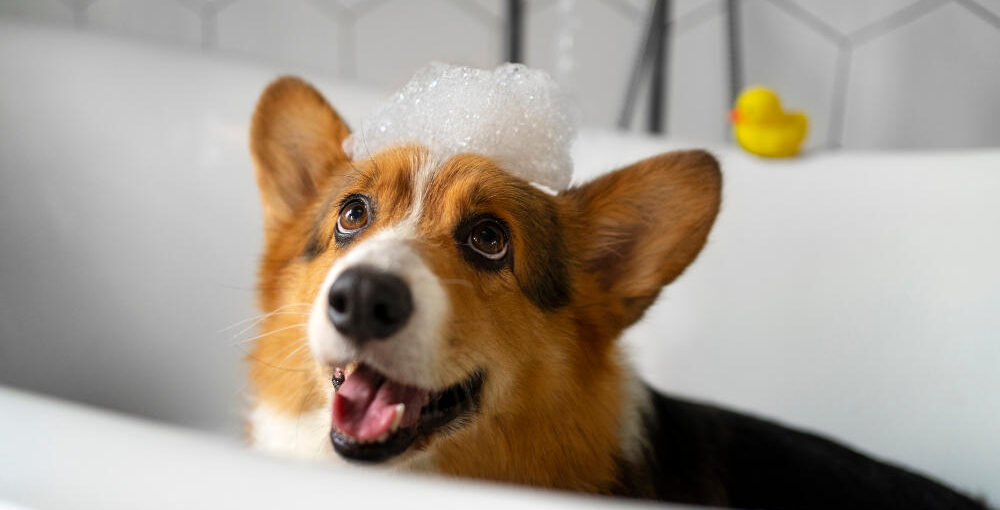Bathing dogs is one of the essential parts of grooming, but do you know everything about this process?
In this article we will explore some topics related to bathing dogs, we will try to understand what the proper frequency is, what skin problems exist, and we will give several hygiene tips for your big dog.
When you get to the end of this article, we want you to feel like an expert!!! So let’s start by understanding the importance of bathing dogs!
#1 Why Bathing Dogs Is Important?
Bathing is one of the most important and beneficial actions we can take towards our dog , it is crucial to maintain all the hygiene and well-being of our friend. In addition to keeping the coat clean and smelling nice, baths for dogs help remove all dirt, soil, and substances that can cause irritation to the animal’s skin.
This is especially important if your dog is one who loves to spend time outdoors, as it is much more exposed to elements such as dust, pollen, fleas, and ticks. Regular bathing is incredibly beneficial as it promotes skin health, preventing problems such as itching, irritation, and skin infections.
On top of all this, the bath is a great time to perform a visual inspection of the dog, trying to identify possible wounds, bumps, or irregularities that may require veterinary attention. Baths not only keep the dog clean, but also promote its comfort, health, and bond with its guardian, thus providing moments of care and affection between the two.
#2 Bath Frequency
So now let’s explore some very interesting topics related to bathing dogs. For starters, and very important, is to realize that how often you bathe has an impact on your dog’s results.
The frequency of bathing varies according to the dog’s coat type and its individual needs. In general, the ideal for most dogs is monthly or bimonthly baths.
Controlling the frequency of bathing dogs is critical because if you bathe your dog too often you can remove the natural oils from the skin, thus causing dry skin and irritation, but on the other hand, if you wait too long between baths you will cause excessive dirt build-up and unpleasant odors.
#3 Skin Problems
We know that some dogs may be more prone to skin problems than others, but in any case it is always important to realize dog baths done improperly can aggravate existing skin problems.
Dogs’ sensitive skin can react negatively to the use of certain grooming products, such as harsh shampoos or those with irritating ingredients, another factor that can affect a dog’s skin is the use of very hot water during bathing.
With all this said, it is important to realize that the right choice of products makes all the difference in preventing skin problems during dog bathing. It is always advisable to choose products that respect the canine skin pH, are gentle and non-irritating.
However, if your dog has persistent skin problems, it is recommended that you consult a veterinarian for proper guidance.
#4 Dog Bathing Tips
Here are some of the most important dog bathing tips you need to know, stay tuned and we hope to surprise you!
- Preparation: Brush the dog’s coat thoroughly before bathing to remove any loose or tangled hair.
- Water temperature: Pay close attention to the water temperature, use warm or room temperature water, try your best to avoid extremes of heat or cold.
- Appropriate products: As we mentioned above, always try to choose dog-specific shampoos and conditioners that are gentle and non-irritating. Avoid products with strong fragrances or harsh ingredients.
- Eye and ear protection: Be careful to prevent water and shampoo from getting into your dog’s eyes and ears. You can use cotton or cotton balls in your ears to prevent water from getting in.
- Thorough washing: During dog baths, gently massage the shampoo into the dog’s skin and coat, avoiding rubbing too hard. Make sure you rinse thoroughly to remove any shampoo residue that may exist.
- Proper drying: Use a clean towel to gently dry the dog, removing all excess water. Dry it completely with a hair dryer, helping it to the lowest temperature and keeping it at a safe distance from the skin.
- Rewards and patience: Always try during the bath to positively reinforce the dog’s behavior, either with affection or food. Be patient and take breaks if necessary, especially if the dog is a little more anxious or uncomfortable.
#5 Special Care
It is very important to remember that every dog is unique, and some breeds or individuals may need special care.
Some examples of this might be dogs from breeds with the longest and densest type of coat. These dogs may need more frequent baths and extra care to avoid knots and tangles.
In addition to these, other examples are dogs of breeds with skin folds, such as Bulldogs, this may require special attention to ensure that these areas are cleaned and dried properly after bathing.
Remember that bathing dogs is not only a matter of hygiene, but also a moment of bonding and affection between you and your big dog. With this article we try to convey to you some important information to ensure that you don’t have any problems during this time.
We believe that every second spent washing your dog turns out to be a demonstration of unconditional love, and so we hope we have contributed to the betterment of that moment!!! <3

